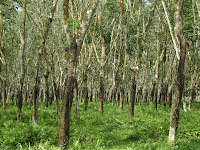How to Control Rubber Plant Weeds - Weed control is intended to reduce competition rubber, with weeds or other plants that grow in the area of rubber plants. Competition between rubber trees with weeds in the form of nutrient absorption, water absorption, competition growing space. Addition of certain weed species such as weeds can secrete substances that inhibit the growth of rubber plants.
Weeds that often grow in the area of rubber plantations, among others: weeds (Imperata cylindrica), Cyperus rotundus, Cyperus killingia, Mikania micranta, Nephrolepis bisserata, Ageratum, and Erchtites valerianifolia. Weed control can be done manually and chemically. In addition, rubber plant was also instrumental in planting weed control in rubber plantations. Weed control in the area of rubber plantations aged less than one year is done manually with weeding the grass in a circle with a radius of 50 cm with the most simple equipment such as hoes, leftovers, fork, and sickle.
Chemical control using herbicides is the kind of control that is often used in plants that are older than one year, weeding can be either circular or following a line of rubber cultivation with 1.5-2.0 meter distance from the tree line. Weeding will depend on the rotation speed of weed growth. In areas with a high rate of growth of weeds, weeding conducted 2-week rotation at all, but at the usual location of weed growth, rotation of weeding can be done 3-4 weeks. In plants produce weed control carried out following the planting of rubber track with a distance of 2-3 meters from the plant row. Spraying is done by hand knapsack sprayer.
Doses of herbicide used depends on the composition of the weed that grows in the area of cultivation, Herbicide dose used should not be too much because it can damage the roots of this plant. Do not forget to continue taking good care of so that your results are high-quality rubber products.
That's some steps we can do to control weeds of rubber plant. weeds can interfere with plant growth so you have to keep weeds from the plants you are cultivating. Plants that grow in areas with few weeds will grow better and faster produce.
Weeds that often grow in the area of rubber plantations, among others: weeds (Imperata cylindrica), Cyperus rotundus, Cyperus killingia, Mikania micranta, Nephrolepis bisserata, Ageratum, and Erchtites valerianifolia. Weed control can be done manually and chemically. In addition, rubber plant was also instrumental in planting weed control in rubber plantations. Weed control in the area of rubber plantations aged less than one year is done manually with weeding the grass in a circle with a radius of 50 cm with the most simple equipment such as hoes, leftovers, fork, and sickle.
Chemical control using herbicides is the kind of control that is often used in plants that are older than one year, weeding can be either circular or following a line of rubber cultivation with 1.5-2.0 meter distance from the tree line. Weeding will depend on the rotation speed of weed growth. In areas with a high rate of growth of weeds, weeding conducted 2-week rotation at all, but at the usual location of weed growth, rotation of weeding can be done 3-4 weeks. In plants produce weed control carried out following the planting of rubber track with a distance of 2-3 meters from the plant row. Spraying is done by hand knapsack sprayer.
Doses of herbicide used depends on the composition of the weed that grows in the area of cultivation, Herbicide dose used should not be too much because it can damage the roots of this plant. Do not forget to continue taking good care of so that your results are high-quality rubber products.
That's some steps we can do to control weeds of rubber plant. weeds can interfere with plant growth so you have to keep weeds from the plants you are cultivating. Plants that grow in areas with few weeds will grow better and faster produce.

Comments
Post a Comment